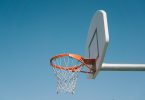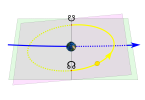When it comes to basketball, there are a lot of terms that are unique to the sport. One of these terms is “traveling.” If you’re new to basketball, you may be wondering what exactly a travel is and why it’s called that. In short, a travel is when a player takes too many steps without dribbling the ball.
To be more specific, a travel occurs when a player moves one or both of their feet illegally. This could be because they take too many steps without dribbling, or because they pivot on one foot and then lift the other foot before dribbling.
Essentially, traveling is any movement that the rules of basketball deem to be illegal. If a player travels, the other team gets possession of the ball.
Definition of Travel in Basketball
In basketball, a travel is a violation that occurs when a player takes more than one step without dribbling the ball. It is also known as walking or traveling with the ball. This violation is called by the referee when a player moves illegally with the ball, and the opposing team is awarded a turnover.
The rule is straightforward: once a player stops dribbling the ball, they are allowed to take only one step before passing or shooting. If a player lifts their pivot foot off the ground before releasing the ball, they are called for a travel. The pivot foot is the foot that is planted on the ground when the player receives the ball or catches it after a rebound.
There are a few exceptions to the travel rule. For instance, if a player catches the ball while running, they are allowed to take two steps before releasing the ball.
Also, if a player falls to the ground while holding the ball, they are allowed to slide one step in any direction before passing or shooting.
It’s important to note that the travel rule is one of the most frequently called violations in basketball. Players must be aware of their footwork and avoid taking unnecessary steps to avoid committing this violation.
Causes of Traveling in Basketball
Improper Footwork
When you are playing basketball, you need to be aware of your footwork. If you take too many steps without dribbling the ball, it will result in a traveling violation. This occurs when a player moves their pivot foot or takes more than two steps without dribbling the ball.
One common mistake is lifting your pivot foot before releasing the ball. This is known as a “traveling” violation. To avoid this, make sure you keep one foot planted on the ground while the other foot moves. You can pivot on your planted foot to change direction or pass the ball.
Ball Handling Errors
Another cause of traveling in basketball is ball handling errors. This occurs when a player loses control of the ball while moving. If you take more than two steps after losing control of the ball, it will result in a traveling violation.
To avoid this, make sure you practice your ball handling skills regularly. Keep the ball close to your body and dribble with control. Don’t try to do too much too quickly, as this can lead to mistakes.
In summary, traveling in basketball is caused by improper footwork and ball handling errors. By practicing good footwork and ball handling skills, you can avoid these violations and become a better player.
Consequences of Traveling in Basketball
When you travel in basketball, it can result in a turnover, which means that your team loses possession of the ball. This can be a frustrating and costly mistake, especially if it happens frequently throughout the game.
In addition to losing possession of the ball, traveling can also result in a foul. If you take more than two steps without dribbling the ball, it is considered a travel and the opposing team will be awarded a free throw. This can also lead to the opposing team gaining momentum and potentially scoring more points.
Furthermore, traveling can also lead to a loss of confidence and trust from your teammates and coach. Consistently making this mistake can make you appear careless and unprepared, which can affect your playing time and overall performance on the court.
It is important to note that traveling is not always intentional and can sometimes occur due to a lack of coordination or balance. However, it is still important to practice and improve your footwork to minimize the risk of traveling during gameplay.
Overall, understanding the consequences of traveling in basketball can help you become a more confident and skilled player on the court.
Preventing Traveling in Basketball
Proper Footwork Training
To prevent traveling in basketball, you need to have proper footwork. You should always keep your pivot foot planted on the ground while moving the other foot. If you move your pivot foot before dribbling or passing the ball, it will result in a traveling violation.
To improve your footwork, you can practice different drills such as the jump stop, hop step, and reverse pivot. These drills will help you develop the muscle memory required to keep your pivot foot planted while moving the other foot.
Ball Handling Drills
Another way to prevent traveling in basketball is by improving your ball handling skills. When you dribble the ball, you should keep it low and close to your body. If you take too many steps while dribbling, it will result in a traveling violation.
To improve your ball handling skills, you can practice different drills such as the figure-eight drill, two-ball dribbling, and dribbling through cones. These drills will help you develop better control over the ball and prevent traveling violations.
By practicing proper footwork and ball handling drills, you can prevent traveling in basketball and improve your overall game. Remember to always keep your pivot foot planted and keep the ball low and close to your body while dribbling.
Famous Traveling Incidents in NBA History
Basketball is a fast-paced game that requires quick movements and precise footwork. However, sometimes players can get carried away and commit traveling violations. Here are some of the most famous traveling incidents in NBA history:
- Allen Iverson’s Double Dribble and Travel: In Game 1 of the 2001 NBA Finals, Allen Iverson of the Philadelphia 76ers made a memorable mistake. He picked up his dribble, then started dribbling again, resulting in a double dribble violation. To make matters worse, he then took an extra step and committed a traveling violation. The Los Angeles Lakers went on to win the game and the series.
- LeBron James’ Uncalled Travel: In Game 2 of the 2018 NBA Finals, LeBron James of the Cleveland Cavaliers appeared to take several steps without dribbling the ball. However, the referees did not call a traveling violation, and James went on to score a crucial basket. The incident sparked controversy and debate among fans and analysts.
- James Harden’s Step-Back Travel: James Harden of the Houston Rockets is known for his signature step-back move. However, in a game against the Utah Jazz in 2019, he took an extra step before shooting, resulting in a traveling violation. The incident led to criticism and scrutiny of Harden’s playing style.
Traveling violations can be costly for teams and players, as they result in turnovers and lost possessions. While some incidents are more memorable than others, they all serve as reminders of the importance of following the rules of the game.
Traveling Rules in Different Basketball Leagues
When it comes to basketball, traveling is a violation that occurs when a player moves illegally with the ball. The rules for traveling can vary depending on the league you are playing in. Here are some common traveling rules in different basketball leagues:
National Basketball Association (NBA)
In the NBA, a player is allowed to take two steps after receiving the ball before they must pass, shoot, or dribble again. If a player takes more than two steps, it is considered traveling. Additionally, a player cannot move their pivot foot once it is established, or it will result in a traveling violation.
International Basketball Federation (FIBA)
FIBA rules are similar to the NBA, but with a few differences. In FIBA, a player is allowed to take one step after receiving the ball before they must pass, shoot, or dribble again. Additionally, a player can move their pivot foot, but only if they do not start a new dribble.
National Collegiate Athletic Association (NCAA)
In NCAA basketball, a player is allowed to take two steps after receiving the ball, but they must release the ball before their second foot touches the ground.
If a player takes more than two steps or does not release the ball before their second foot touches the ground, it is considered traveling. Additionally, a player cannot move their pivot foot once it is established, or it will result in a traveling violation.
Youth Leagues
Youth basketball leagues often have different rules for traveling, as they are designed to accommodate younger players who may not have the same level of skill as older players.
In some youth leagues, players are allowed to take an extra step or two before they must pass, shoot, or dribble again. However, it is important to note that these rules can vary depending on the league and age group.
In conclusion, understanding the traveling rules in different basketball leagues is important for players and coaches alike. By knowing the rules, you can avoid committing traveling violations and improve your overall performance on the court.







